The Best Way to Cook an Old Hen, Coq au Vin
It’s almost time to get new chicks. Farm stores stock baby chicks in March and we plan to get a half a dozen this year. Hens lay eggs reliably for the first 3 years of their lives, but can live for over a decade. When we got our chickens, we did so knowing one day we would need to get a new flock, and come to terms with eating the old ones. As chickens age, the meat becomes very tough and requires different cooking techniques. After trying a few recipes, we made some delicious French cuisine that left us craving more.
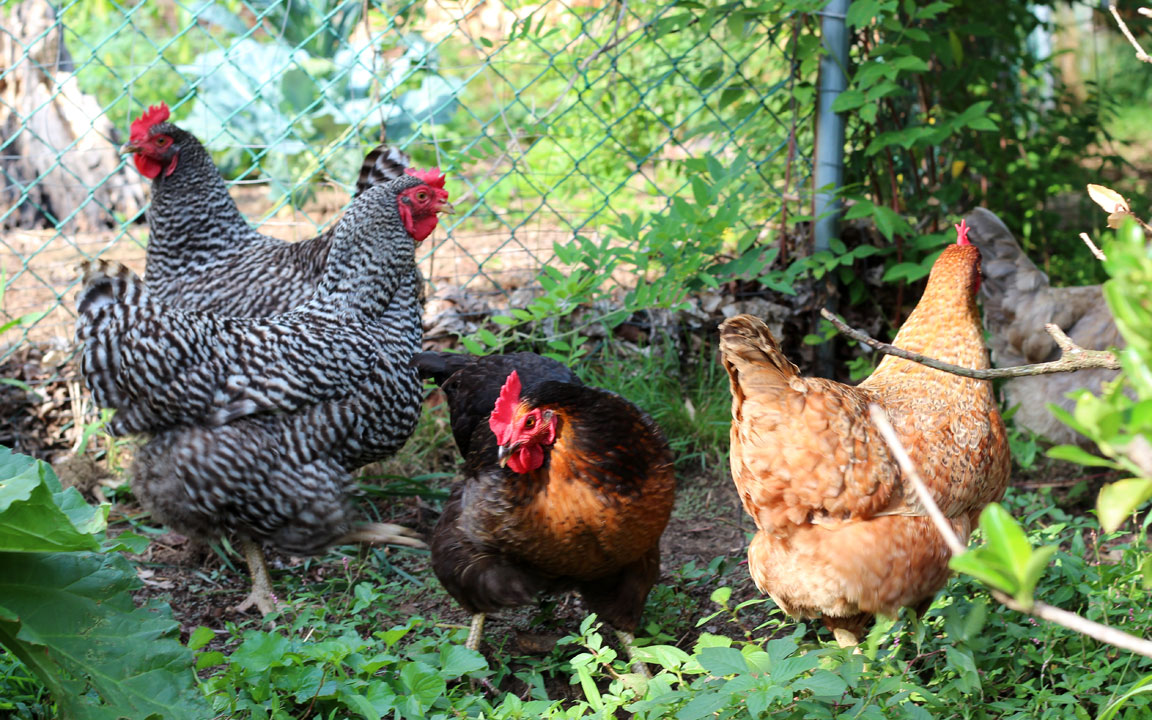 Tasty birds
Tasty birds
We butcher our chickens once the egg production slows
I don’t know if I’ll ever get used to butchering chickens, but I haven’t been doing it for very long either. Having raised these birds since they were chicks and knowing each of their personalities make it harder. But we had one hen that was a paranoid nutcase. She was scared of everything and the other hens picked on her. The resulting stress made her lay eggs with soft shells which broke easily, making a mess of the nesting box. She had past her good days, and it was time to cook this old hen.
Butchering isn’t easy for me. But for folks like my grandfather who grew up through the great depression, butchering a chicken meant you were having a very good day. For thousands of years, the slaughter of an animal was a celebration and sign of a feast to come. I want our hens to go out in the same fashion.
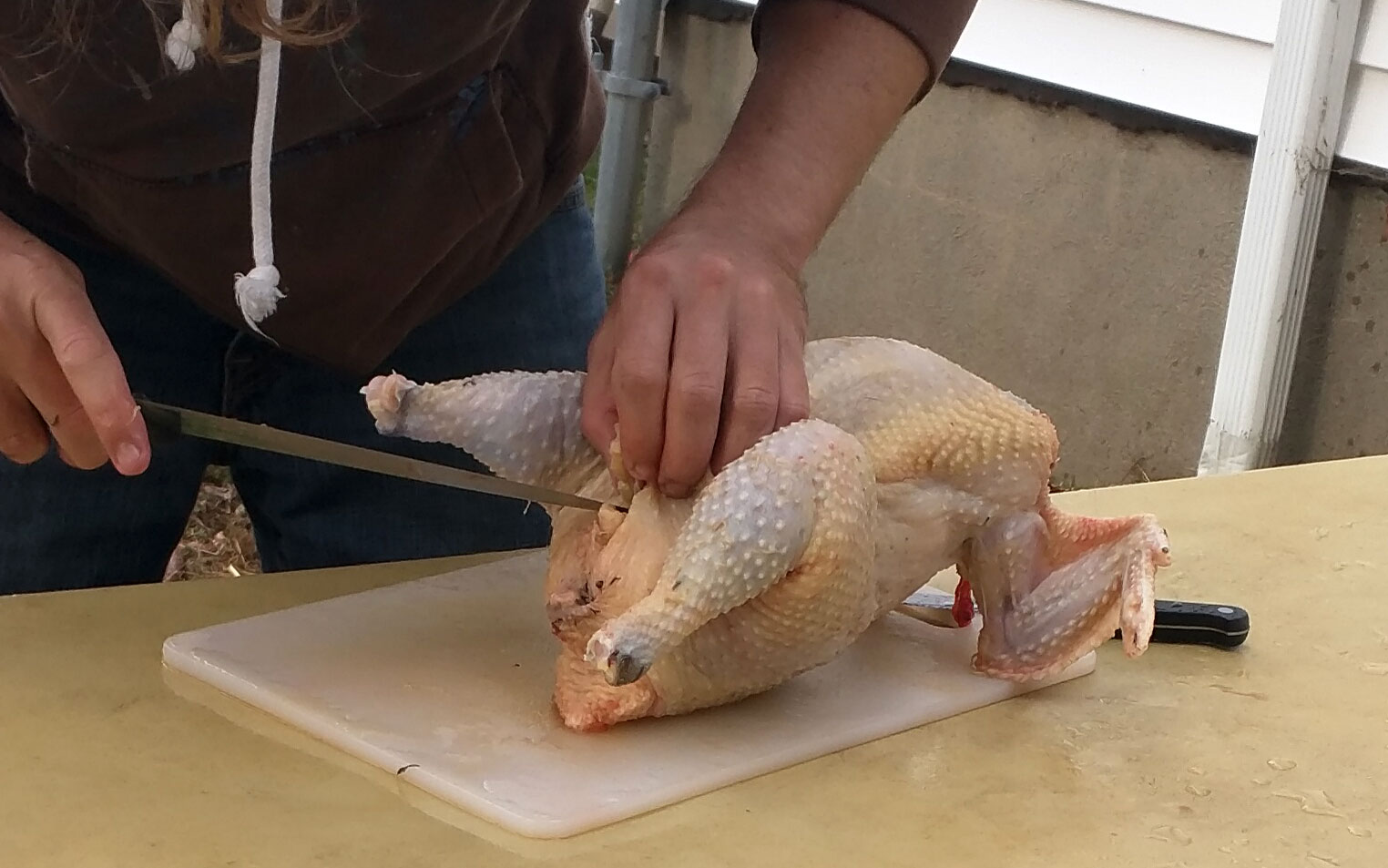 La boucherie
La boucherie
As I cleaned the giblets, and cleared the feathers, the chicken started to look like something from a French boucherie. Our chickens spend their days eating bugs and grazing on grass which gives their fat a rich, golden color. I split the chicken in two portions so I could try a couple of recipes.
A friend once told me an old Croatian saying, “Old hens make good soup.” With the first half of the chicken, I tried making a basic chicken and vegetable soup. I’m clearly not an old hen, because the soup I made wasn’t very good at all. The meat turned out like leather. It was nearly impossible to chew, and didn’t bring out the best in our farm raised bird.
This first attempt left me a bit disheartened, but people have been eating their old hens for thousands of years. I decided to try a classic French dish, Coq au Vin, or Cock with Wine. Like many great dishes, Coq au Vin comes from humble peasant origins. At its core, this recipe deals with preparing tough meat that the rich deemed inedible.
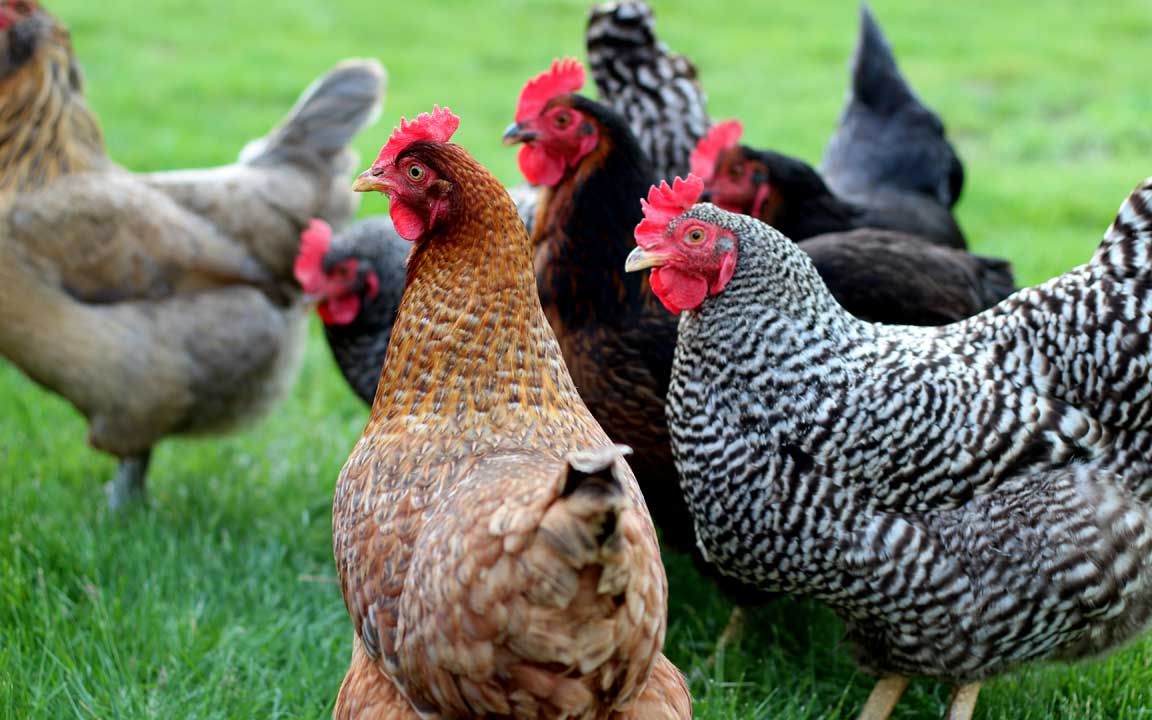 Tough old birds
Tough old birds
How to prepare Coq au Vin with an old hen or rooster
After some searching, I found this Coq au Vin recipe for cooking an old hen or rooster. It took some time to prepare, but the results were phenomenal. It brought out the best in our home raised chicken, and smacked of something that might have been served at a haute cuisine restaurant. The Coq au Vin turned out so good in fact, that I’m now looking at our remaining ladies a little differently.
My version is not the exact French recipe (I used whiskey rather than Cognac) but I can attest that the resulting braised chicken was outstanding.
Dry age the meat in the fridge
Before preparing the bird, I rested the meat in my fridge for just over a week. During a good dry aging, naturally present enzymes break down connective tissue in the muscles tenderizing the meat. You can skip this step if you are buying chicken from the store.
Mise en place – get your shit together
Things can get a bit intense, and the French like to have all the ingredients ready and waiting. This recipe isn’t too complicated and the ingredients include:
1/2 of a cut up chicken
4 pieces of bacon cut into lardons or short strips
1/3 of a cup of Cognac (I used Whiskey since I didn’t have any brandy)
1 bottle of red wine
1 tablespoon of tomato paste
1/2 teaspoon thyme
1-2 bay leaf
4 cloves of garlic
salt
pepper
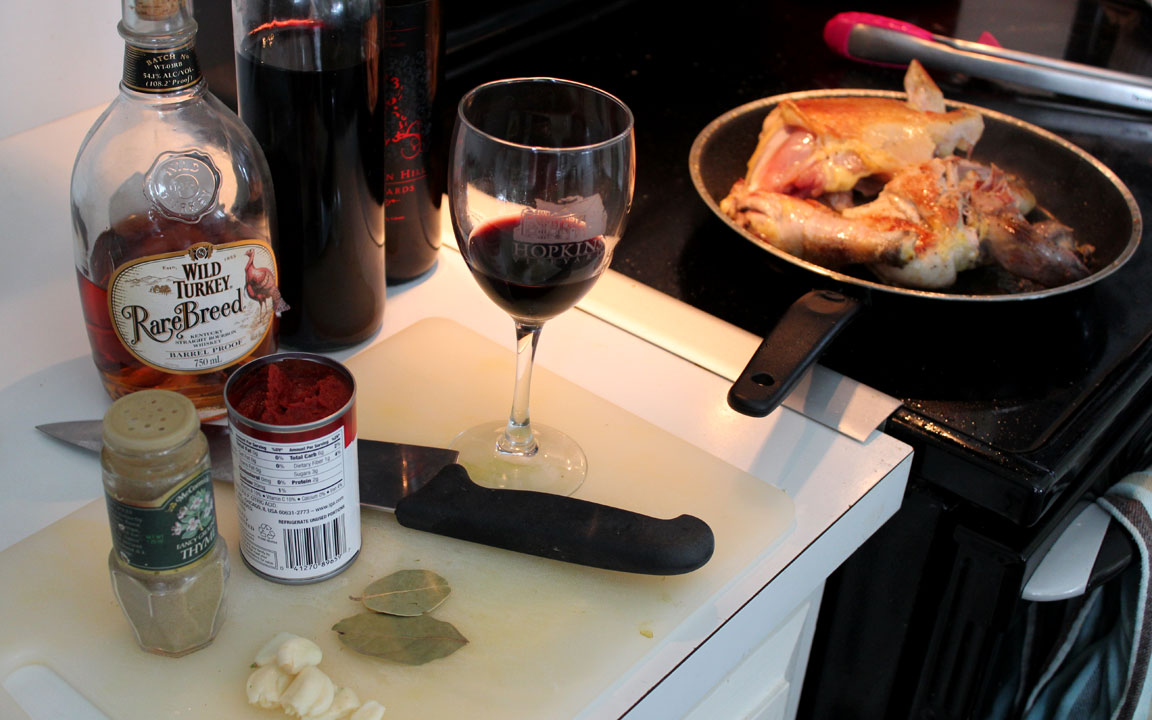 Mise en place
Mise en place
Fry the bacon and brown the chicken
Fry up the bacon until it’s crispy, then set aside. Leave all the nice bacon grease in the pan.
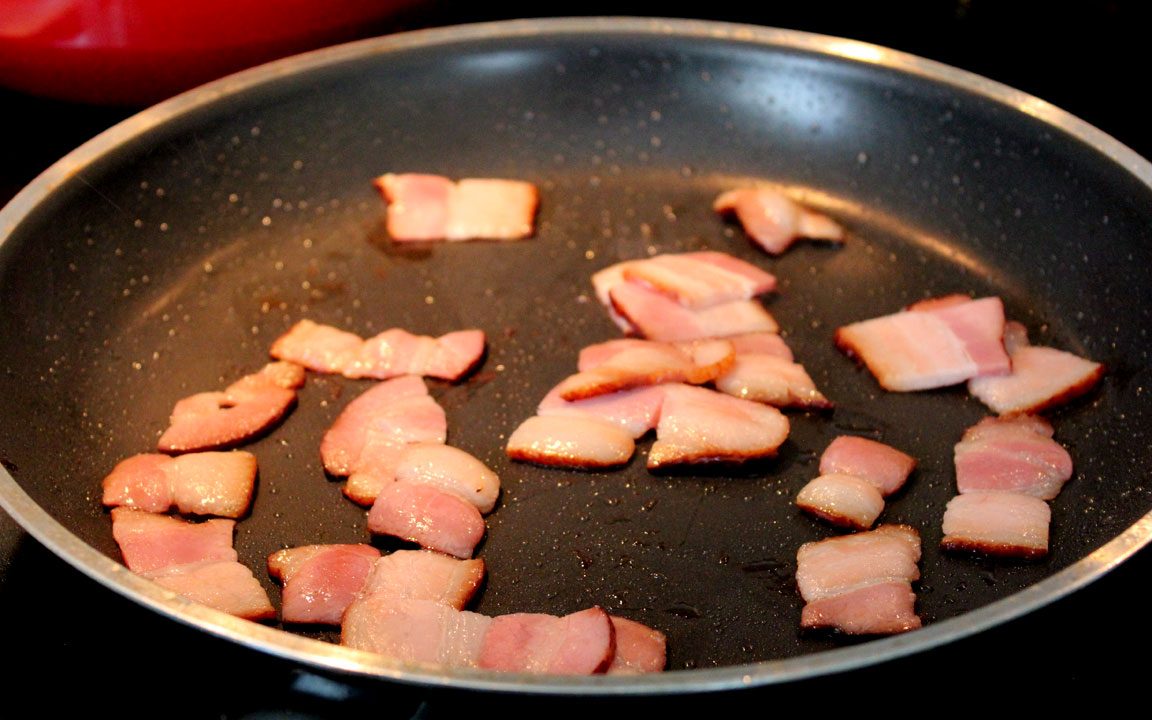 Mmm… bacon.
Mmm… bacon.
Salt the chicken and fry the pieces in the bacon fat until brown. Heat should be high enough to crisp the skin without burning it.
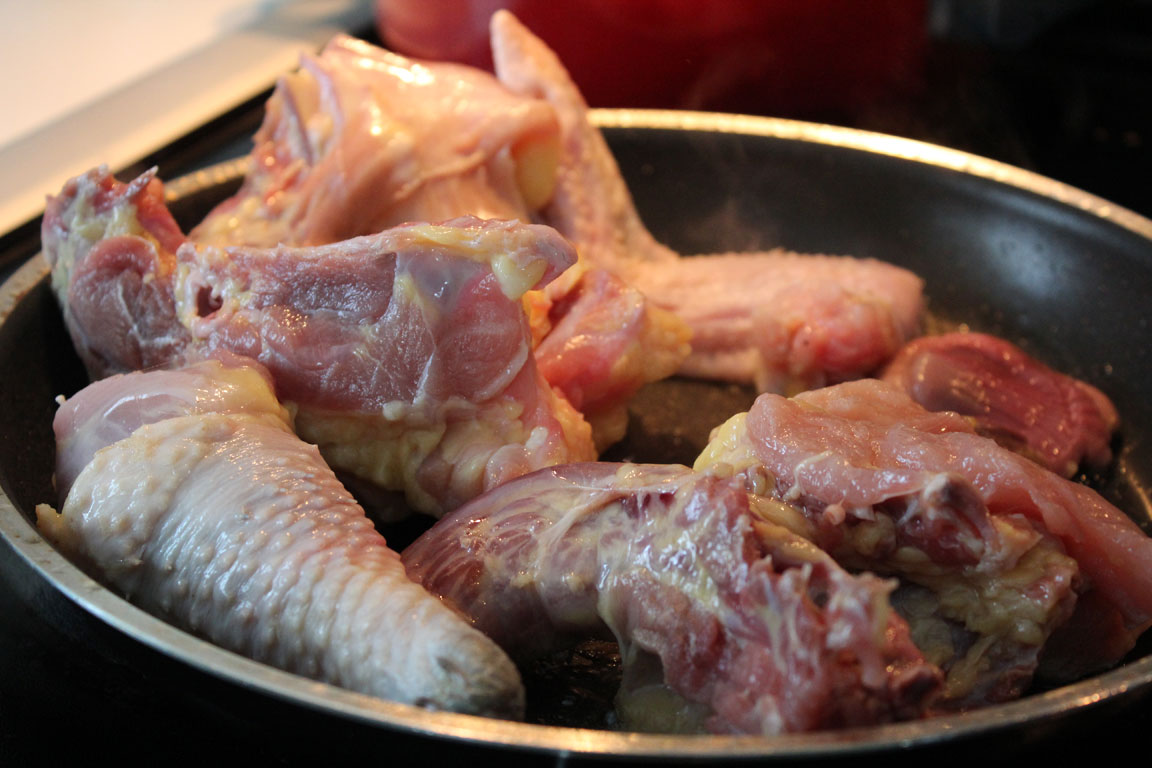 Look at that rich yellow fat.
Look at that rich yellow fat.
Relax while the chicken browns – this takes about 5 minutes. You can spend the time enjoying some of that cheap red wine.
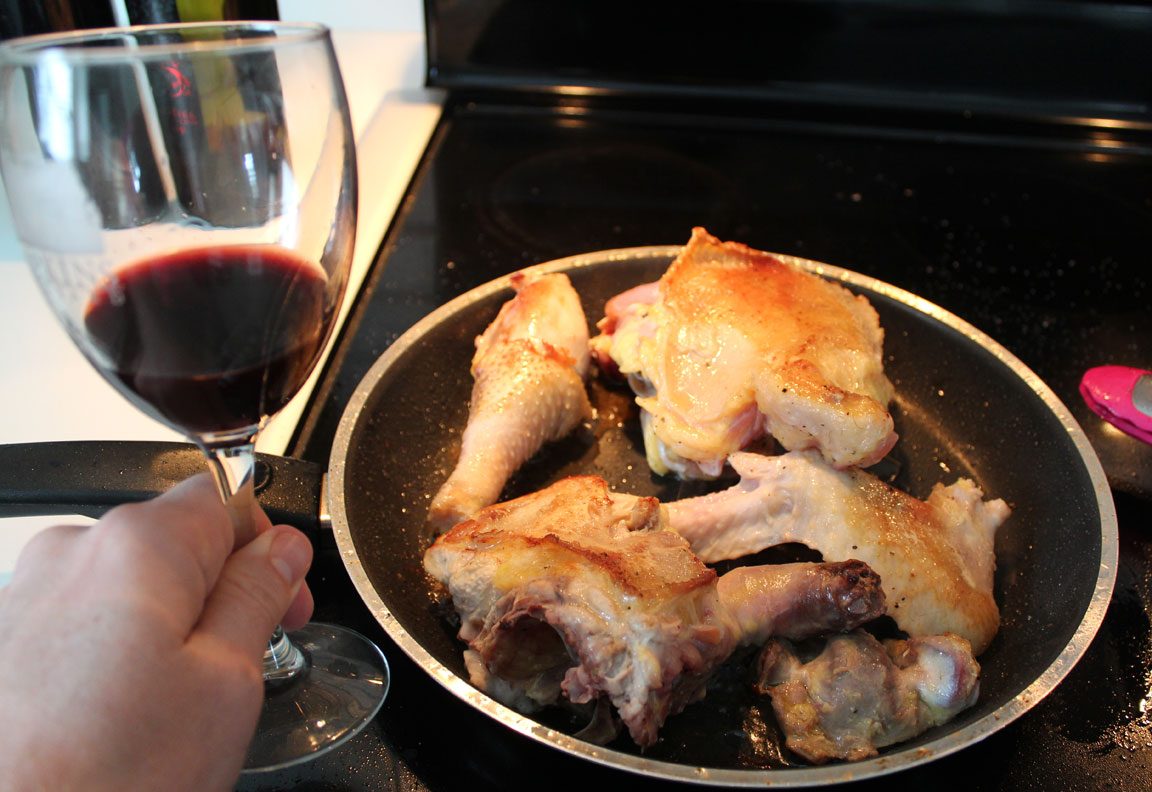 Santé!
Santé!
Flambé that sucker
</span>
This is the coolest part of the recipe. Once the chicken is browned, dump the whiskey/Cognac into the hot pan and light it up.The size of the flame was surprising – make sure there is nothing flammable (like a greasy hood vent) above your pan.
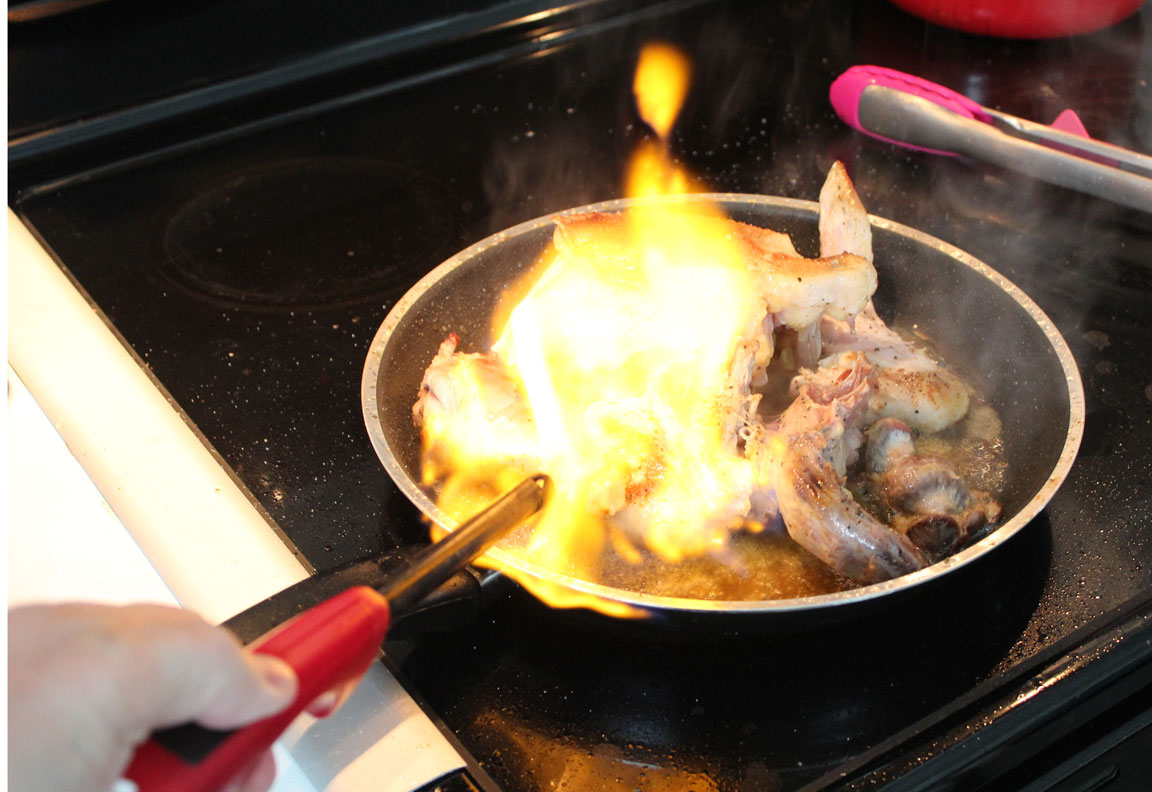 Dump in the booze and light it up.
Dump in the booze and light it up.
In addition to a camera, you might want to have a fire extinguisher ready, don’t ask me how I know. Your significant other will be very impressed when they see the flames, but not if you burn the house down.
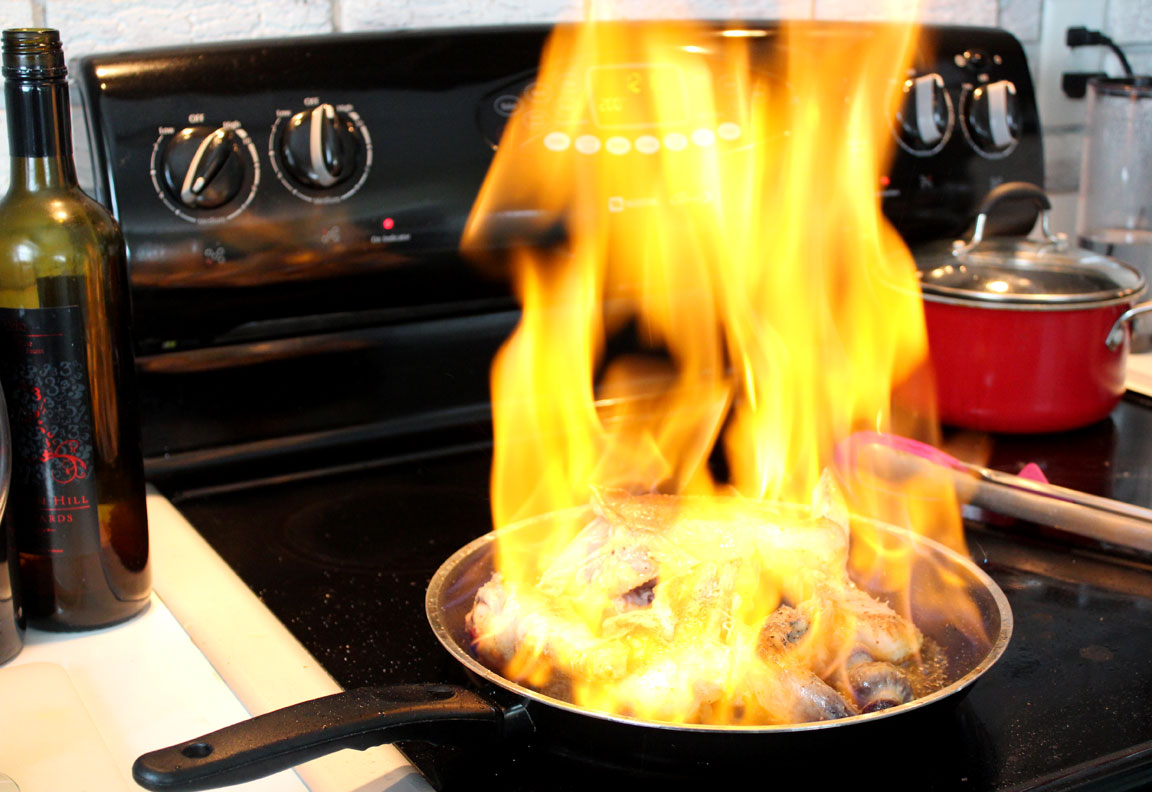 Don’t burn the house down.
Don’t burn the house down.
Add the wine and remaining ingredients
Add the wine, tomato paste, garlic, thyme, bay leaf, and salt to taste. Cook it in the pan just long enough for the ingredients to mix together properly.
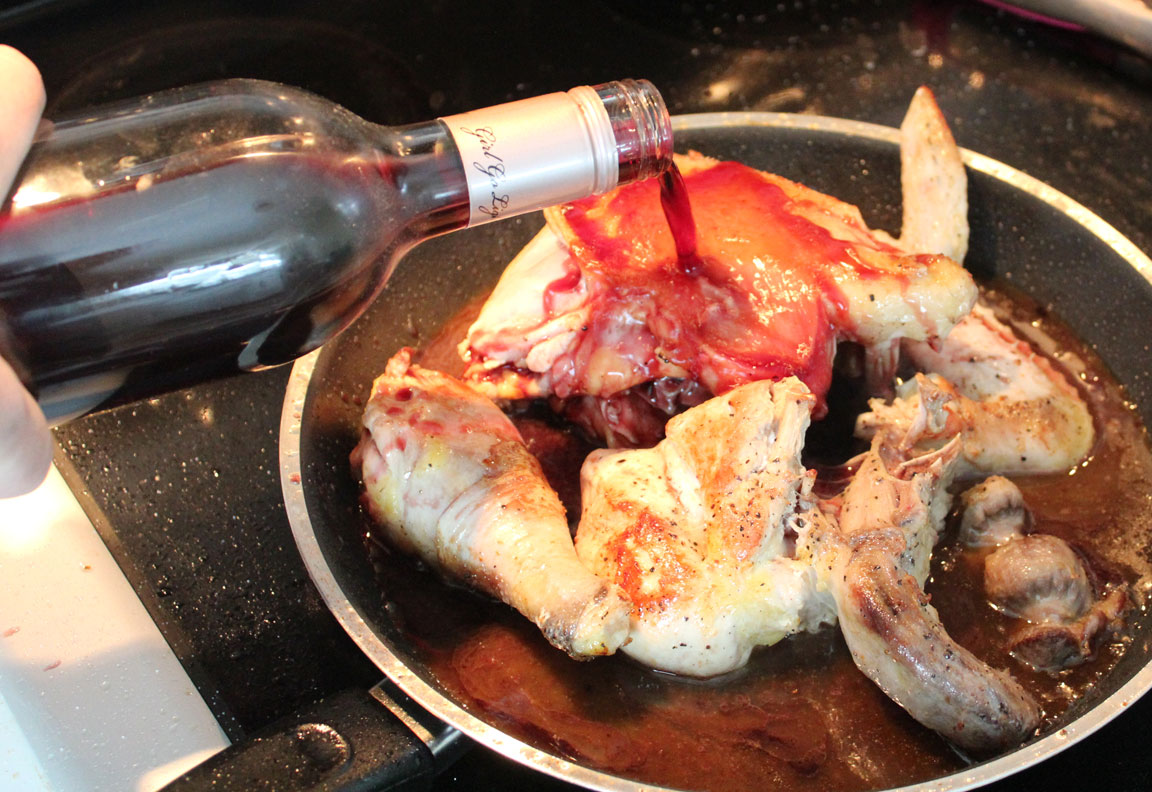 Add the wine and remaining ingredients.
Add the wine and remaining ingredients.
Bake it low and slow for 4+ hours
Add the bacon back in, and put all the ingredients into a casserole dish, or just cover the pan for baking. Slow cooking in acidic wine is key to a tender bird. An old hen or rooster should cook at 200 deg F for 4 hours or more.
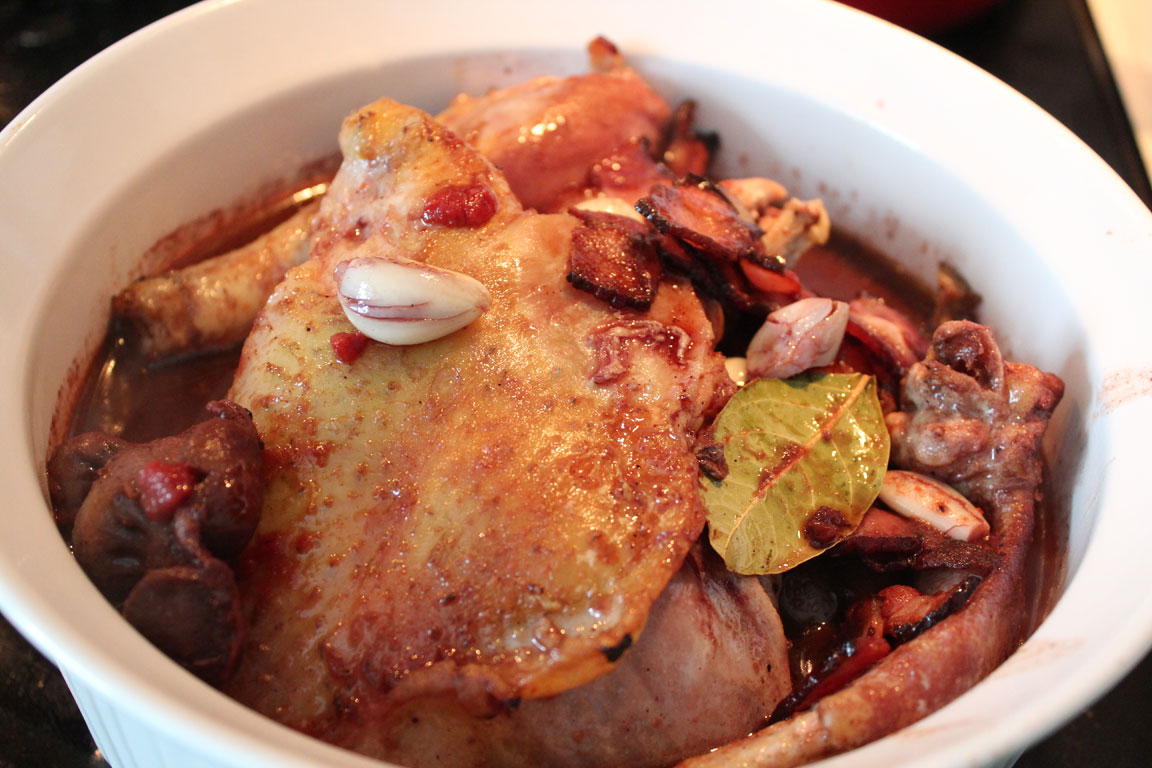 I used a covered casserole to finish braising the chicken.
I used a covered casserole to finish braising the chicken.
Make the gravy
After the baking is complete, place the liquid into a pan on low heat and whisk in flour to desired consistency. Add pepper and salt to taste.
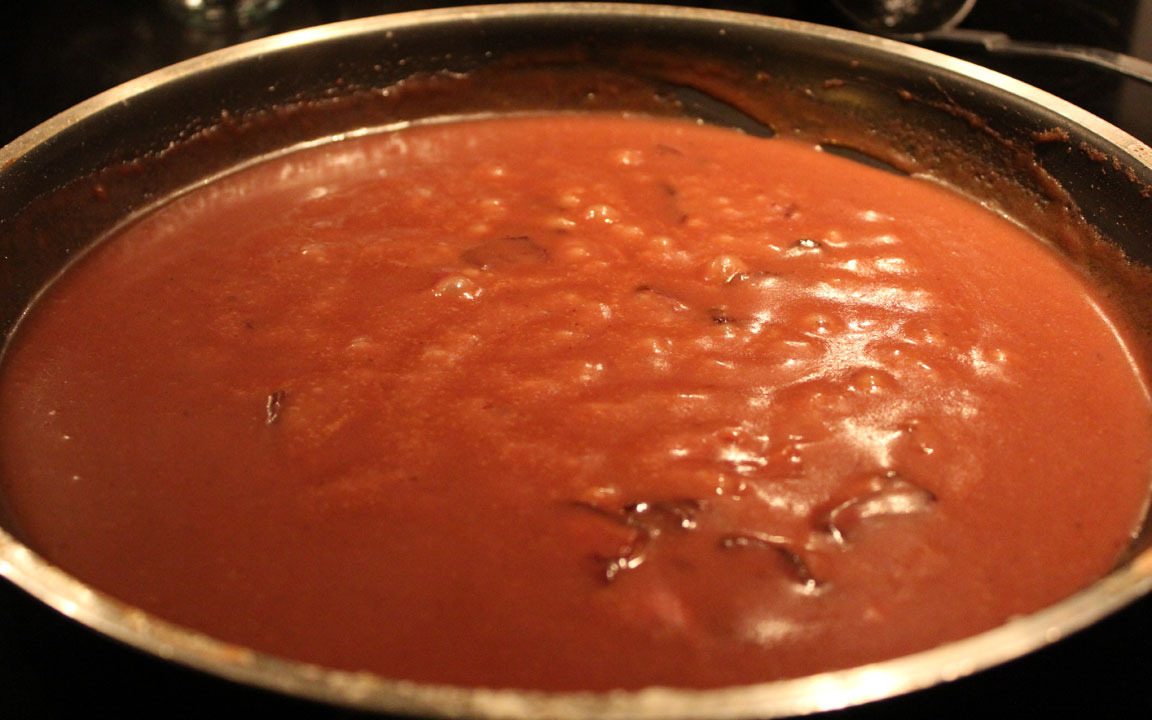
Make the sides
Traditionally, this dish is served with caramelized onions and sauteed mushrooms. But we had a big Blue Hubbard squash that we had stored in our garage since the fall. I figured this would be a perfect time to roast up some of our homegrown squash to go with our homegrown chicken.
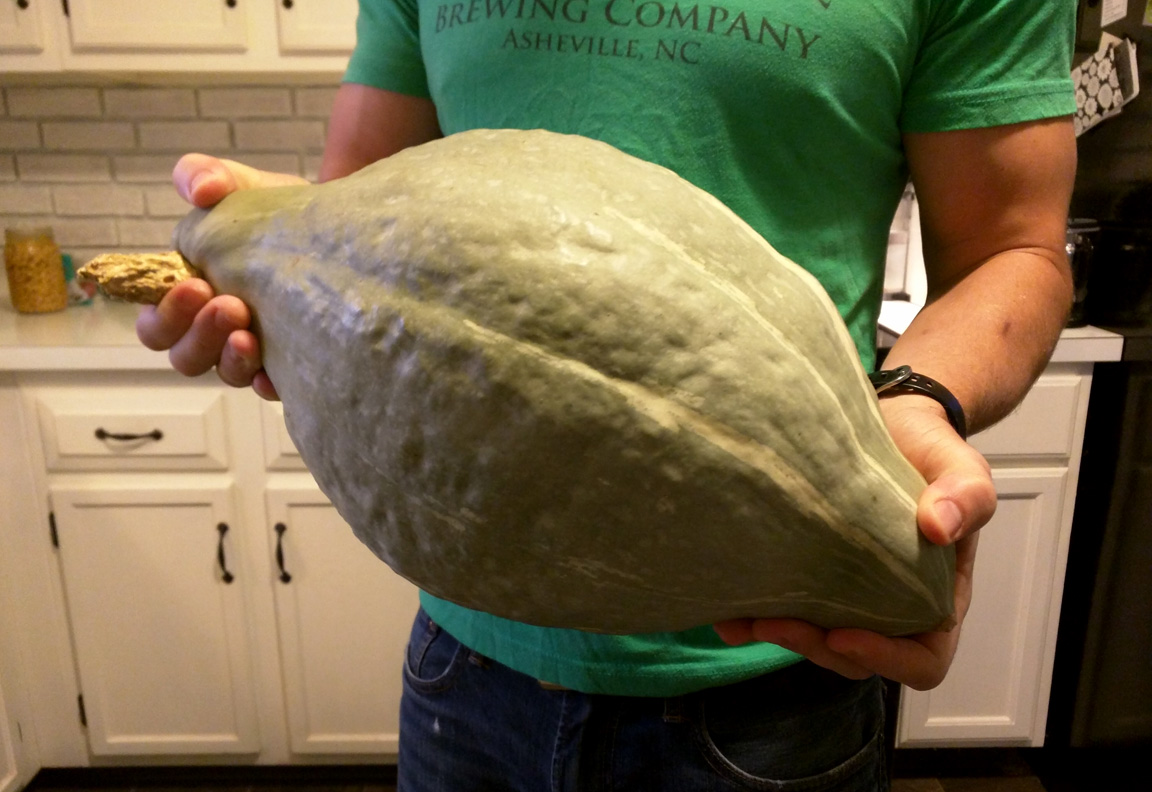 Roasted homegrown squash makes for a great side.
Roasted homegrown squash makes for a great side.
Enjoy your fancy ass cuisine
I’m very happy to have found a special, delicious way to prepare our old chickens. The meat was incredibly juicy, tender and flavorful. The flavors of caramel from flambéing combined with the acidic wine and flowery thyme were sublime.
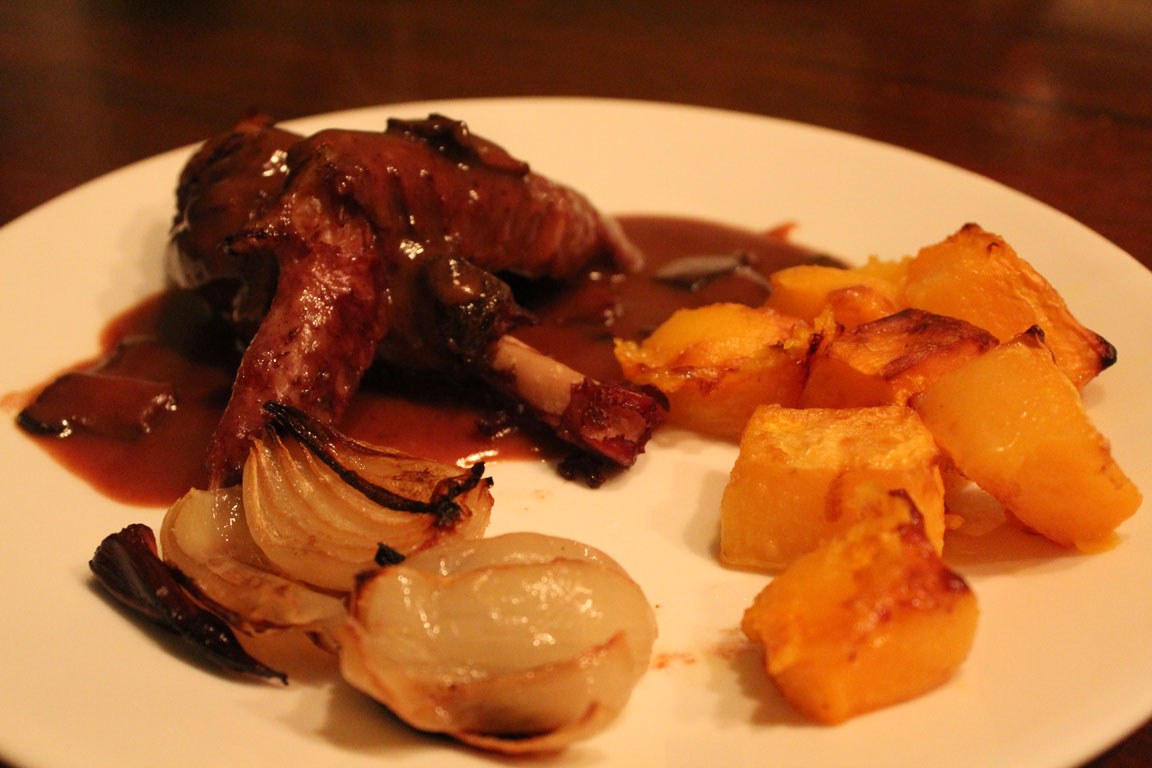
This recipe was awesome with our old hen, would be excellent with an old rooster, and I’m sure it would be delicious with a regular broiler chicken. If you want to enjoy some gourmet cuisine without breaking the bank, this is a great recipe to try. You even get to light it on fire, and who isn’t down for some classy French cooking?